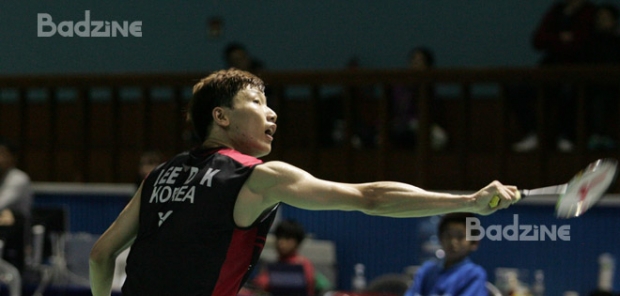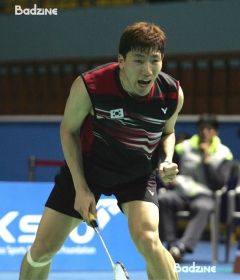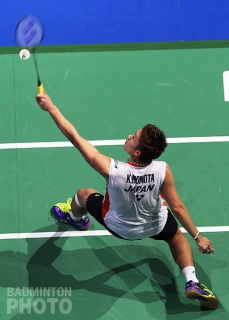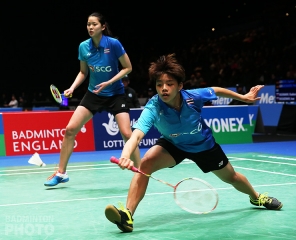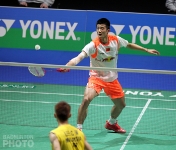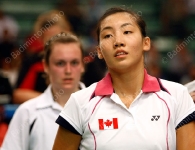Lee Dong Keun booked his spot in the Rio Olympics as the second Korean representative but along with his second straight win over Hu Yun, he benefited from a mysterious apparent rule change from world badminton’s governing body.
By Don Hearn. Photos: Badmintonphoto and Don Hearn (archives)
Going into this week’s Badminton Asia Championships in Wuhan, Korea’s Lee Dong Keun (pictured) had a slim chance of emerging with a ticket to the Rio Olympics. In this, the last tournament in the Olympic qualifying period, he had to reach the quarter-finals in order to pass Rajiv Ouseph and enter the top 16, the threshold for qualifying two players from one country.
Although Lee did just that, he would still have woken up today facing the prospect of having to beat the great Lin Dan to claw his way back into the top 16 if it weren’t for the Badminton World Federation (BWF) pulling a rabbit out of their regulation hat. Actually, it was more like waving a magic wand and making Kento Momota (pictured below) disappear from the world ranking lists altogether.
Lee posted back-to-back upsets, first beating Kidambi Srikanth of India and then seeing off Hu Yun of Hong Kong, whom he had beaten just two weeks earlier at the Singapore Open. The latter victory should have pushed Lee up to #16 in the rankings but with Momota completely disappearing, suddenly from #16, with no change in his points, Ouseph went to #15 and that is where Lee overtook him.
Ouseph’s 3rd round victory at the European Championships later the same day allowed him to pull back in front but rather than having his Rio hopes relying on a quarter-final victory over Lin Dan in Wuhan, Lee slips back to a comfortable 16th spot with no one left able to oust him on any continent.
The case of the disappearing stars
Where this regulation change came from is still a mystery. The BWF has made public no disciplinary action against Momota. Even after Bodin Issara was suspended for fighting in 2013, he still remained on the rankings, as did players who had officially retired, such as Juliane Schenk (ranked 24th in the world one month after her retirement on March 1st, 2014).
In fact, Momota is not the only player to disappear from the new Race to Rio standings. Also newly removed from the penultimate week’s standings were Zhang Beiwen of the USA in women’s singles (shown ranked #31 on last week’s lists) and Gronya Somerville / Mapasa Setyana of Australia in women’s doubles (ranked #35 last week).
Only Momota, however, has completely disappeared from the world ranking lists, not just from the Race to Rio standings. Zhang Beiwen, by contrast, is still there this week at #33. The Olympic Qualifying Regulations for Rio 2016 clearly state that the qualifying decisions will be made based on ‘the World Ranking Lists of 5 May 2016’, not on the Race to Rio standings, which are topped by a disclaimer saying they are merely ‘a representation of who could qualify’.
As it turns out, it was not only Momota’s disappearance that affected the qualifiers’ list. With the Australians removed, Egypt’s Menna Eltanany / Nadine Ashraf briefly poked their head into the top 50, where they could avail themselves of the continental qualifying spot for Africa. However, a few European pairs, along with Amitrapai/Chochuwong of Thailand have since bumped them back out for good.
If nothing else, the fact that Momota – the only shuttler whose removal would actually change who qualifies – has also disappeared from the official current world ranking list means that there will be no inconsistency with the stated rules should the BWF invite Lee Dong Keun, even if he were to remain at his new #16 spot. In other words, removing players like Zhang Beiwen and Somerville/Setyana – who have apparently been confirmed as ineligible – could be justified as a simplification of the ‘representation’ that is the Race to Rio standings even if they use the slightly different lists for actually deciding who is invited.
Lee’s windfall could also spell disappointment further down the ranking list. Before Korea ended up with two Rio tickets, Lino Munoz was holding the last non-continental spot. Even with Petr Koukal jumping the queue, Munoz should have been entitled to the re-allocated host country ticket, given that Ygor Coelho de Oliveira qualified outright. At this point, Munoz joins Ville Lang and others in waiting for an unused tripartite spot if any become available.
Déjà vu
This is actually the second time that a Korean men’s singles shuttler booked his Olympic spot in the very last qualifying event. Four years ago, it was Son Wan Ho who had to score his first ever victories over Peter Gade and Lee Chong Wei in order to go to London. If history really repeats itself, Lin Dan, Chen Long, and Lee Chong Wei could be in for surprises this weekend.
More Rio developments in Wuhan…
The other developments in Wuhan include the women’s doubles, where Thailand’s Puttita Supajirakul / Sapsiree Taerattanachai (pictured above) reached the quarter-finals and thus inched ahead of compatriots Kititharakul/Prajongjai. The battle in the top 8 has yet to be decided as Naoko Fukuman / Kurumi Yonao still have a chance to replace Jang Ye Na / Lee So Hee if they can reach the final. Both pairs face top Chinese pairs in today’s quarter-finals.
Kenta Kazuno and Ayane Kurihara may have lost early in Wuhan but a 2nd round upset suffered by their only remaining pursuers, Durkin/Vislova of Russia, means that the Japanese duo will get the 14th spot in mixed doubles.
As for the upsets, the biggest was perhaps the loss of defending champion Ratchanok to Sayaka Sato (pictured) of Japan. Three others all involved Indonesian men’s doubles pairs. Marcus Fernaldi Gideon / Kevin Sanjaya Sukamuljo continued their run of form by beating Korea’s Kim/Kim, while Pratama/Suwardi and Ahsan/Setiawan both suffered upsets.
Click here for complete Thursday results from the Badminton Asia Championships
Editor’s note: At the time of writing, the BWF had not yet responded to queries about these deletions from the ranking lists. Later on Friday, April 29th, the body issued a press release clarifying certain aspects of the situation, including reference to a 2014 BWF Council decision “that any player suspended for more than a year would be removed from all rankings”. The press release does not address what would happen if the removal of ineligible players from the Race to Rio lists were to cause changes to qualifiers because of changes to the composition of the top 8, top 16, or top 50.
![Upset and rule change send Lee to Rio? Lee Dong Keun booked his spot in the Rio Olympics as the second Korean representative but along with his second straight win over Hu Yun, he benefited from a mysterious […]](https://www.badzine.net/wp-content/uploads/ngg_featured/IU5G3156_rotator.jpg)
